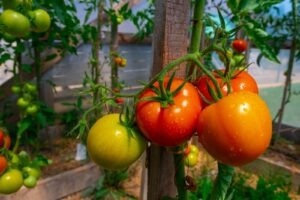Reviewed by Danielle Ellis, B.Sc.Jan 10 2024
Recently, The Plant Journal’s cover highlighted an innovative study that has garnered attention in the interesting field of plant biology.

Image Credit: Boyce Thomson Institute
The study explores the complex defense systems that tomatoes employ to fend off the infamous bacterial disease Pseudomonas syringae pv. tomato (Pst). It is a well-known story of nature’s arms race: plants respond with increasingly complex immune systems as infections evolve to outwit the defenses.
The Boyce Thompson Institute (BTI) lab of Dr Greg Martin employs scientists whose research forms the basis of this paper. Nucleotide-binding leucine-rich repeat receptors (NLRs), which are proteins that resemble plant immune system fighters, are at the center of the research.
When a pathogen assaults, the receptors detect it and react, starting a chain reaction of defense processes. Among these are the helper NLRs, Nrc2 and Nrc3, which cooperate in a well-coordinated defense against Pst with the tomato NLR Prf and its partner kinase, Pto.

Image Credit: eugenegurkov/Shutterstock.com
The novel feature of this work is its investigation of the functions of Nrc2 and Nrc3. The researchers generated tomato mutant plants devoid of these NLRs by using CRISPR technology. Under normal circumstances, these mutants looked normal, but they showed heightened Pst vulnerability, akin to plants devoid of the Prf protein.
This finding was pivotal, highlighting the indispensable role of Nrc2 and Nrc3 in the tomato immune response.”
Dr Ning Zhang, Post-Doctoral Researcher and First Author, Boyce Thomson Institute
The comprehension of Nrc2 and Nrc3’s roles in the defense system as a whole is one of the most fascinating results of the research. Nrc2 and Nrc3 appear to function upstream in the signaling pathway that causes programmed cell death, which is an essential part of the plant’s defense mechanism. Nrc2 and Nrc3 thus serve as crucial bridges in the intricate web of plant immunity.
The attention to Zhang’s research is a validation of its significance.
I’m thrilled that our discoveries on the workings of helper NLRs received prominent coverage in The Plant Journal. Our work sheds light on how plants defend themselves - a topic of immense importance in agriculture.”
Dr Ning Zhang, Post-Doctoral Researcher and First Author, Boyce Thomson Institute
In essence, the research by Zhang and colleagues is not just a story of scientific discovery; it is a roadmap for future innovations in crop resilience.
Zhang concludes, “By unraveling the roles of helper NLRs like Nrc2 and Nrc3, we are a step closer to developing crops that can better withstand the challenges posed by pathogens, helping ensure food security and agricultural sustainability.”
Source:
Journal reference:
Balcerowicz, M. (2023). Bolstering the defence line: The vital role of helper NLRs in tomato disease resistance. The Plant Journal. doi.org/10.1111/tpj.16591